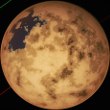|
Ancient Stars around super massive black holes
|
|
| denixen | Date: Friday, 09.01.2015, 21:14 | Message # 1 |
|
Observer
Group: Newbies
 Pirate
Pirate
Messages: 1
Status: Offline
| I recently noticed that super massive black holes have a great number of stars orbiting them. This of course nothing new or special, but I did notices something curious.
In really ancient galaxies (~12.8 billion years, one billion years after big bang (!)) the (obviously) equally ancient super massive black hole is surrounded by ancient stars (often as old as the galaxy, 12.8 billion years in some cases). This is again nothing surprising, some stars are expected to remain in main sequence for many times the age of the universe. But these stars are not that kind of star.
The ancient stars surrounding the black holes are often white main sequence stars, white giants and even a few blue giants. White sequence stars can live for a long time, but usually not more than around 2 billion years. Blue giants are so hot they usually only last a few million years, a couple of hundred at best.
How on earth can stars that have an expected life time of only a tenth of even a thousandth of their current life still be around? Does it have to do with the fact that time that close to a black hole of that size get slow down so drastically, that in their own time, these star have only existed for a few million years? Or is it just a limitation in the game engine that only allows one age for all objects in a system?
Edited by denixen - Friday, 09.01.2015, 21:15 |
| |
| |
| Ingolifs | Date: Friday, 09.01.2015, 22:30 | Message # 2 |
|
Space Tourist
Group: Users
 New Zealand
New Zealand
Messages: 30
Status: Offline
| I have noticed there's not much variety in the star system around supermassive black holes. The black hole itself is almost always about 100 million solar masses, and there are 24 objects total in the system. Most of these are blue stars of some description, with a couple of red dwarfs and maybe a brown or white dwarf. I believe i've seen a neutron star or stellar black hole once. Red giants never get generated, it seems.
|
| |
| |
| Tangle10 | Date: Saturday, 10.01.2015, 00:28 | Message # 3 |
 Space Pilot
Group: Users
 United States
United States
Messages: 129
Status: Offline
| It might be a space engine limitation- I've seen that planets around a star have no or very very little variance in the age compared to the star, and moons even less.
Tips for finding Earth-Like planets: Look for F, G, or K Class stars. M class habitables will almost always be tidelocked. Oceanias can, of course, also be habitable, they just have tiny amounts of land.
|
| |
| |
 ENG
ENG




 Pirate
Pirate 


 New Zealand
New Zealand  United States
United States